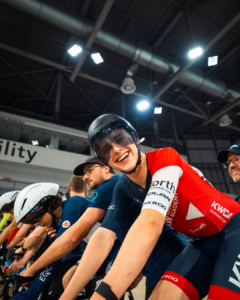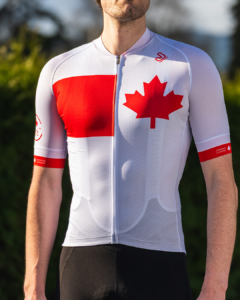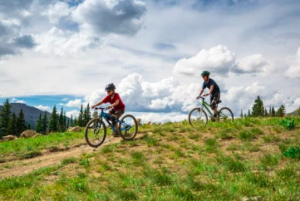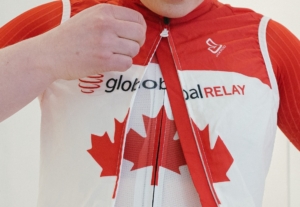HOW I LEARNED TO STOP WORRYING AND LOVE THE TRACK
By Meghan Brown, para-cycling pilot and 2019 Para Pan American Games gold medallist
It’s May 2, 2019. I arrive at the Calgary Velodrome and hop over the gate to make my way down to the infield where my stoker Carla Shibley and our coach Phil Abbott are waiting. Thankfully, there aren’t many people around I think to myself. I walk over to the sign-in table and my hand is trembling as I pick up a pen to sign in. I try to act normal, but my mind is racing. I think back to the last time I was here four years ago and shudder. That experience ended with a bang: broken ribs, cracked scapula, a mild concussion, and some minor post-traumatic stress that I was pretty good at ignoring up until now. After that day I vowed to never ride the track again and yet there I stood, trying to act normal, when in fact I was terrified.
Fast forward about an hour, and Carla and I are riding the blue line at a causal pace, dropping down every few laps to do some faster efforts in the pole lane. We take a break to chat with Phil. He is calm and patient. I hate feeling like someone needs to baby me and hold my hand, I remember thinking. “Relax,” says Phil. “Your tendons are popping out of your arms. Loosen up.” “You’ve got this. I believe in you!” Carla chimes in. I’m reluctant, but out we go again, and again, and again.
Fast forward to October 19, 2020. We embark on a five-day camp at the facility in Burnaby, British Columbia. This track is much shorter and steeper than I’m used to. We walk into the building and my heart starts to race when I see the track firsthand. Carla and I do a couple of easy laps around the apron, and I think to myself, screw it. Now or never. “Hit it!” I bark at Carla and up we go! Instincts take over, and I try to ignore the steep banks and stronger g-forces in the corners, riding much faster than we probably need to during a warmup. By the end of the week I was grinning ear-to-ear after hard efforts. I left with a strong desire for more of this fast, ridiculous “type one” fun.
What on earth would drive someone to force themselves to do something that their mind and body is screaming at them not to do? The first and most obvious reason is that I had no choice! After Carla and I had some early season success on the road (2019 was our first year racing together), there was a small possibility that we could be selected to compete at the Para Pan American games in Lima, Peru. I was told (quite bluntly) to either get over my fears or that I would never progress to racing on the international stage. Talk about an ultimatum! Thankfully, I was surrounded by a capable and patient team of people that were willing to help. My problem was being afraid to ask for help, and displaying just how scared I actually was. I don’t like showing vulnerability, and I’m reluctant to trust in processes that are out of my control (as my personal coach Jack Van Dyk will attest). But most of all, I was reluctant to trust myself.
Riding the tandem is an experience often hard to put into words. However, one thing for certain is that it requires considerable amounts of trust from both people on the bike. Not just from Carla (for obvious reasons, she can’t see what’s going on); I also rely on her to stay smooth and balanced during corners and descents, to blindly trust my judgement when it’s time to hammer and when it’s time to back off, and to give 100% effort whenever I ask for it. Carla trusted that I would learn to ride the track while keeping us safe. While I found that trust to be baffling given my previous track record (so to speak), I couldn’t let her down by not even trying.
The tandem is unique in the sense that I can always feel Carla’s pressure on the pedals as force is transferred through the timing chain. So I know she is always there with me. Whether it’s on a long easy endurance ride or our first world cup, we are connected. Aside from the physical connection, we have forged a mental one as well. We have learned to stay positive and believe in each other, even while down in the deepest, darkest pain caves, and this has brought out the best in both of us. Why suffer on a long training ride, or march off into battle (also known as a bike race) alone, when you can do it with a friend? Having Carla along for the ride has helped ease my anxiety over the track immensely.
To this day I am still baffled that Phil took a tandem team with a stubborn, anxious pilot (who didn’t even want to ride the apron) to the top spot on the podium in Lima in a very short time frame. It took a conscious effort on my part to let go and trust that his plan wasn’t going to lead me into a trap. Phil still jokes when I am hesitant, “Have I ever led you into a trap?” As an ever-questioning skeptic, this was especially hard for me to do. My personal coach Jack obviously had a massive role to play here as well on the fitness side, and I have slowly learned to let go and trust in his processes as well.
I never would have made the journey from roadie to self-proclaimed “trackie” alone, and I can’t thank the people who have helped me enough. It can be hard to learn to let go and trust in others (and in yourself), but as they say, it’s better to have tried and failed horribly than to have never tried at all. Through success or failure, I know Carla will always have my back (quite literally, it’s all that she can see!). That in itself is all the reward I need.








